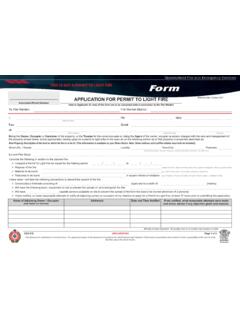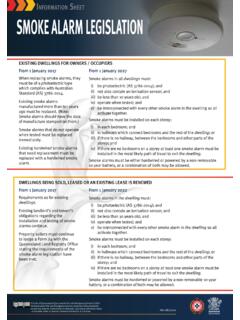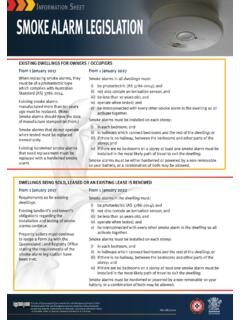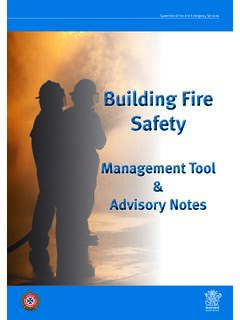Transcription of Queensland Fire and Emergency Services
1 Queensland Fire and Emergency Services Table of Contents 1. 2. Introduction ..3. 3. Where Do These Guidelines Apply? ..3. 4. Water Supply Figure 1 Reticulated Hydrant Figure 2 Use of Hydrant Figure 3 Hydrant Figure 5 Marker/directional arrow spacing Figure 4 Hydrant marker Figure 6 Location of cats eyes on a sealed Figure 6 Hydrant System design to minimum 5. Vehicle Access 6. Figure 7 Vehicle Turning Glossary of Terms In this document, the terms are limited to the meanings described below. Building: A building is a fixed structure that is wholly or partly enclosed by walls or is roofed. Structure: For this document refer to definition of a Building. Fire Truck: A vehicle used to combat a fire. A typical fire truck (a pumper) is approximately wide, long and it is typically used in urban residential areas.
2 Further specifications of fire trucks and larger trucks are available from the QFES if design solutions are required for specific situations. Hydrant: An assembly installed on a branch from a water pipeline, which provides a valved outlet to permit a supply of water to be taken from the pipeline for fire fighting. These include above and below ground hydrants. QFES: Queensland Fire and Emergency Services . Material Change As per the Planning Act 2016. of Use: Reconfiguration As per the Planning Act 2016. of a Lot: Reticulated Is a permanent infrastructure provided to deliver treated water to lots from an Urban Utility Authority Water Supply: through a system of pipes, mains, control valves etc. for household or industrial use. It will supply uninterrupted water at a positive pressure for fire fighting purposes.
3 Road or Construction which is specifically designed for all vehicle travel (may or may not include a sealed top Carriageway: surface layer). A Constructed For the purpose of defining widths, includes the part of the road reserve set aside for traffic and also Road: includes roll-over kerbs but does not include the remaining part of the road reserve. Trafficable Refers to that width of the constructed road that is unimpeded by encroachments such as street furniture or Width: landscaping, and is available for free movement of fire trucks. State of Queensland ( Queensland Fire and Emergency Services ) 2019. The Queensland Government, acting through the Queensland Fire and Emergency Services (QFES), supports and encourages the dissemination and exchange of publicly funded information and endorses the use of the Australian Governments Open Access and Licensing Framework (AusGOAL).
4 All Queensland Fire and Emergency Services material in this document except the QFES logo, any material protected by a trademark, and unless otherwise noted is licensed under a Creative Commons Attribution licence. The Queensland Fire and Emergency Services has undertaken reasonable enquiries to identify material owned by third parties and secure permission for its reproduction. Permission may need to be obtained from third parties to re-use their material. Written requests relating to the copyright in this document should be addressed to: Intellectual Property Coordinator Legal Services , Ministerial and Executive Services Public Safety Business Agency GPO Box 9879, Brisbane 4001. EM: Disclaimer To the extent possible under applicable law, the material in this document is supplied as-is and as-available, and makes no representations or warranties of any kind whether express, implied, statutory, or otherwise.
5 This includes, without limitation, warranties of title, merchantability, fitness for a particular purpose, non-infringement, absence of latent or other defects, accuracy, or the presence or absence of errors, whether or not known or discoverable. Where disclaimers of warranties are not allowed in full or in part, this disclaimer may not apply. To the extent possible under applicable law, neither the Queensland Government or the Queensland Fire and Emergency Services will be liable to you on any legal ground (including, without limitation, negligence) or otherwise for any direct, special, indirect, incidental, consequential, punitive, exemplary, or other losses, costs, expenses, or damages arising out of the use of the material in this document.
6 Where a limitation of liability is not allowed in full or in part, this limitation may not apply. 2 - Public - Fire Hydrant Guidelines (Effective: 03/2019). 1. Scope For applications seeking development approval for material change of use or reconfiguring a lot for the purpose of building, where streets and common access ways are proposed regardless of building classification. Where reticulated hydrant systems and vehicle access are not currently required under the Planning Act 2016 (PA), the Building Act 1975 or National Construction Code (NCC) the measures in this document should be adopted. Australian Standard (AS) 2005 Appendix B is a minimum standard of design and performance for the State of Queensland . In a local government authority where a local water authority specifies a design and performance criteria above the requirements of AS 2005 Appendix B, the local water authority requirements will be adopted.
7 For the installed reticulated hydrant systems the minimum water flow rate and pressure is to be 10 L/S. @ 200 Kpa as per AS 2005 Table (for buildings with Class 2-9 only). In a local government authority where a local water authority specifies a flow rate and pressure above the requirements of AS. 2005 Table , the local water authority requirements will be adopted. For fire truck access, a minimum width and height clearance for roadways is required. Constructed roads must comply with Government legislation such as the Road Planning and Design Manual . 2. Introduction Queensland Fire and Emergency Services (QFES) is the primary provider of fire and rescue Services throughout Queensland . QFES is responsible for community safety, the protection of people, property and the environment from fire and chemical incidents and, in conjunction with other agencies, the rescue of people trapped in vehicles, buildings and other Emergency situations.
8 The loss of life and property damage by fire in residential, commercial and industrial premises is a major concern to QFES, and for this reason, these lot reconfigurations need to be designed to provide ready access for fire trucks, whilst providing a fire fighting water supply from a hydrant system. Water supply and access requirements for material change of use or reconfiguring a lot within this document are a planning tool and advice for building and developer applicants, it is not the intent of this document for land development applications to be referred to QFES. They outline fire safety requirements to enable QFES to efficiently manage fire incidents. This document reflects Queensland Government policy of promoting sustainable development that achieves economic, social and environmental objectives, including safety.
9 The provisions are flexible allowing planners and designers to economically achieve safety objectives without compromising aesthetics or amenity. 3. Where Do These Guidelines Apply? These guidelines apply to all material change of use or reconfiguration of a lot that will include streets and common access ways within a common private title in areas serviced by reticulated water within Queensland , for residential buildings, both attached and detached commercial or industrial buildings that are not covered in other legislation or planning provisions. For example, this would apply to planned townships or reconfigurations regardless of current fire service intervention. Fire Hydrant Guidelines (Effective: 03/2019) - Public - 3. 4. Water Supply Specification Installed reticulated hydrant systems are to be located on roadways or access ways for all material change of use and reconfigured lots for fire fighting purposes as per AS 2005 Appendix B that provides a minimum standard for hydrant intervals.
10 In a Local Government Authority where a local water authority specifies a design and performance criteria above the requirements of AS 2005. Appendix B, the local water authority requirements will be adopted. For the installed reticulated hydrant systems the minimum water flow rate and pressure is to be 10. L/S @ 200 Kpa as per AS 2005 Table (for building Class 2-9 only). In a Local Government Authority where a local water authority specifies a flow rate and pressure above the requirements of AS. 2005 Table , the local water authority requirements will be adopted. Hydrant Provision: Hydrant Provision Expectation Acceptable Outcomes Where reticulated water is Hydrants above or below ground should be provided and maintained to available, operable hydrants the minimum required performance standard as per AS 2005.









